Archives
Why Going to the Dentist May Help You Prevent Migraines
Can you guess what’s the strongest muscle in the human body? Many muscles, including the tongue, the heart, and the gluteus maximus have been deemed the strongest muscles of the human body. But when it comes to sheer force there is one muscle that’s above all others: the masseter.
The masseter is a thick, flat muscle located in the cheeks, and it is part of what we call the “jaw muscles.” When the muscles of the jaw work together, they can close your back teeth (molars) with a force of up to 200 pounds and 95 pounds on the rest of your teeth. We use the jaw muscles every day to talk and chew.
But sometimes we clench our jaws involuntarily, exerting too much pressure in or around the face and temples. Bruxism is the abnormal and involuntary clenching or grinding of the teeth that may occur during the day or at night while we sleep. Your dentist may diagnose you with bruxism during a regular dental check-up based on changes in your teeth. When it’s left untreated, the constant grinding of your teeth can lead to several different problems, including damage to your temporomandibular joins leading to the development of TMJ disorder.
Bruxism symptoms
Signs and symptoms that you have bruxism include:
Chipped or flattened teeth
Tight or locked jaw
Tooth sensitivity
Loud grinding noises
Sore gums
Headaches or migraines
Facial pain
Earache
Jaw popping
Facial spasms
Bruxism and migraines
Migraines are a type of chronic neurologic disorder that causes intense, debilitating pain. Though the exact cause is not fully understood, experts know that migraines can be triggered by factors such as stress, the weather, loud noises, some types of foods, etc. During a migraine attack, a person might experience daily bouts of pain that last up to a week.
Bruxism, temporomandibular joint disorder (TMJ), and toothaches have also been shown to trigger migraines in some individuals because they create tension around the head. In fact, a research study conducted in 2016 showed that migraine sufferers ground their teeth more – especially around the molar region – than those who didn’t suffer from migraines.
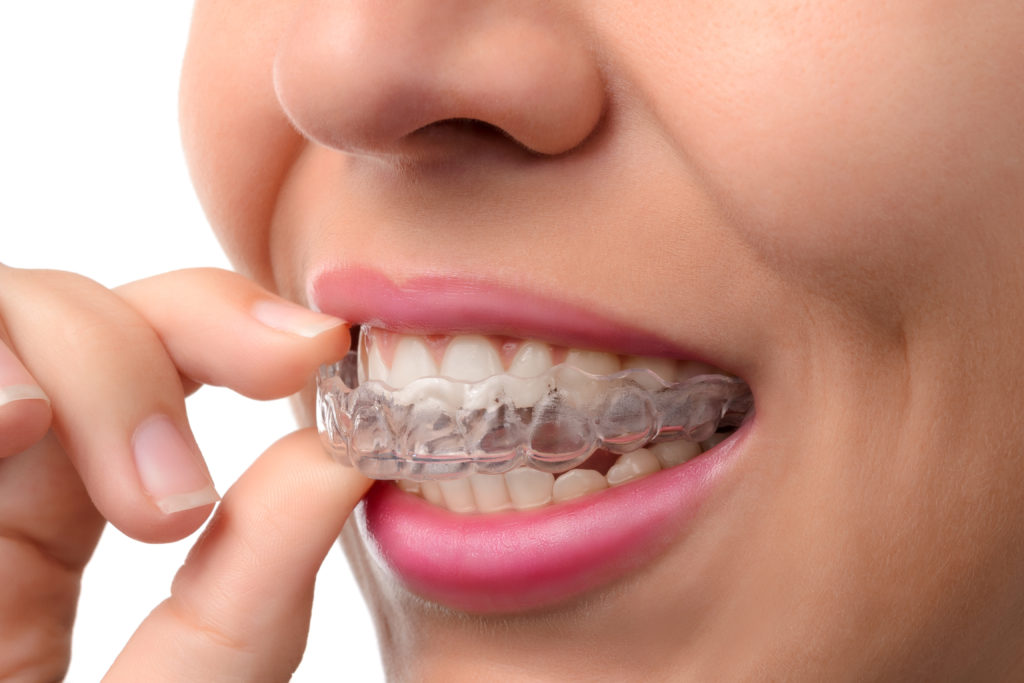
Treating bruxism
If you find yourself tensing your jaw, grinding your teeth, or you wake up with jaw pain, you might have bruxism or TMJ disorder. Untreated jaw disorders can wear down your teeth (attrition), aggravate migraines and cause tension headaches.
Fortunately, there are treatments available that can help prevent further tooth damage and ease the pressure off your jaw. Talk with your dentist to learn about the options available for bruxism and TMJ, including:
Mouthguards or splints: these are the best options if you are a night-time grinder because they keep the jaw in a rested position. Mouthguards can fit over your top or bottom teeth and their goal is to separate your top and bottom molars. Usually, your dentist will make an impression of your teeth and then mold the mouthguard accordingly so it can be as comfortable as possible when you use it.
Self-massage: use your fingers to massage your jaw in a circular or downwards motion applying constant, gentle pressure. Alternatively, with your mouth open, use your hand to gently push one side of your jaw. Hold it for 10 seconds and then repeat on the other side.
Medications: If your bruxism or TMJ is severe, your doctor may prescribe muscle relaxants to help ease tension off the area. Botox injections have also been shown to be effective at temporarily reducing clenching and alleviating jaw pain.
Sleep Supplements – For many people, stress and trouble sleeping can be the cause of bed-time teeth grinding and jaw pain. Taking a natural sleep supplement with ingredients clinically shown to promote deep sleep and reestablish healthy sleep patterns can make all the difference.
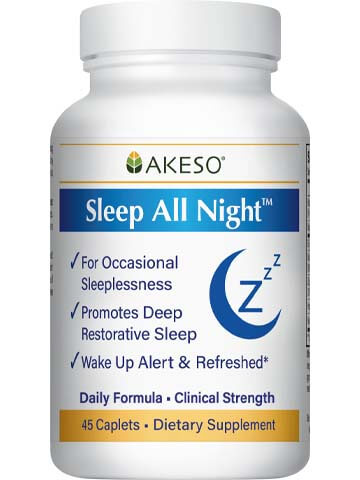
Slow-wave sleep, also called deep sleep, is an important stage in the sleep cycle that enables proper brain function and memory. It is also the stage where all of your body’s rejuvenating and healing occurs. While most adults are aware that they should aim for between 7 and 9 hours of sleep each night, the science of sleep is quite complex. The two main categories of sleep are called rapid eye movement (REM) sleep and non-REM sleep, and each has important stages. Humans cycle through these stages in a somewhat regular pattern as they sleep, and a full night’s rest means cycling through these stages a few times before waking up.
Taking a sleep supplement to get both better sleep and more deep sleep each night, not only allows a person to wake up feeling more rested and refreshed, often it helps avoid teeth grinding and waking with jaw pain.
Famous People with Migraine
Migraines have long plagued some of the most brilliant minds, talented artists, and elite athletes throughout history. From rulers and philosophers to musicians and sports legends, this condition knows no boundaries. While migraines can be debilitating, the experiences of these remarkable individuals remind us that perseverance, creativity, and resilience can thrive despite chronic pain.
The Politicians
Roman dictator Julius Caesar and French emperor Napoleon Bonaparte suffered from migraine, as did Queen Elizabeth I and II, and King Henry VIII. U.S. president and principal author of the Declaration of Independence Thomas Jefferson. and both Robert E. Lee, Commander-in-Chief of Confederate armies during the American Civil War, and Ulysses S. Grant, the Union general who overcame Lee’s troops and went on to become U.S. president also suffered from migraine.
The Writers
Migraine has influenced the work of many writers, among them Lewis Carroll, Virginia Woolf, and Miguel de Cervantes. Carroll’s Alice’s Adventures in Wonderland, and Through the Looking-Glass and What Alice Found may have been drawn from the feelings of bodily distortion and light sensitivity and auras experienced by some people with migraine.
Han Kang: The Nobel Prize-winning South Korean novelist, known for works like “The Vegetarian,” has suffered from debilitating migraines since childhood. She has described experiencing “extreme mental and physical pain” while writing, noting that her migraines have given her the humility and empathy essential to her writing.
Siri Hustvedt: The acclaimed author has written about her migraine experiences, detailing symptoms such as visual hallucinations and sensory disturbances. She describes sensations like “fogs and gray spots” and a feeling of a “heavy cloud” in her head, which have influenced her creative process.
Oliver Mol: The Australian writer endured a continuous 10-month migraine that left him in a state of “catatonic panic.” This profound experience significantly impacted his life and work, leading him to explore the depths of chronic pain in his writing.
These authors, among others, have provided valuable insights into the intersection of creativity and chronic pain, highlighting the profound impact migraines can have on the creative process.
The Painters
 Impressionist painter Vincent Van Gogh is reputed to have suffered from severe migraines. Some speculate that his strokes of pure color were inspired by visual disturbances from migraine auras. Van Gogh’s works includes some of the most acclaimed paintings ever created – Sunflowers, Irises and The Night Café.
Impressionist painter Vincent Van Gogh is reputed to have suffered from severe migraines. Some speculate that his strokes of pure color were inspired by visual disturbances from migraine auras. Van Gogh’s works includes some of the most acclaimed paintings ever created – Sunflowers, Irises and The Night Café.
Georgia O’Keeffe (1887–1986), the American modernist painter experienced severe migraines, which often forced her to take breaks from painting. Some art critics speculate that her abstract, soft-edged floral paintings may have been inspired by scotomas (blind spots) and visual distortions caused by migraines.
The Thinkers
Philosophers throughout history have often engaged with pain and suffering, sometimes integrating their personal experiences with migraines into their work on perception, reality, and consciousness.
Sigmund Freud, the “Father of Psychoanalysis,” is thought to have suffered from migraine. Freud’s radical views challenged 20th century society’s view of itself and the world with his provocative theories on the psychology of human sexuality and dream interpretation.
The German philosopher and poet Friedrich Nietzsche (1844-1900) considered one of the most influential thinkers of the 19th century, was also plagued by migraines throughout his life. His frequent attacks, accompanied by nausea and vision problems, often left him bedridden for days. Nietzsche’s struggles with chronic illness are reflected in his existential and introspective works, such as Thus Spoke Zarathustra and Beyond Good and Evil.
Siri Hustvedt a contemporary philosopher and writer, has openly discussed her experiences with migraine, including aura-related hallucinations and sensory distortions. She explores the link between neurological phenomena and perception in works like The Shaking Woman or A History of My Nerves.
Oliver Sacks (1933–2015) suffered from migraine and experienced auras and scotomas (visual disturbances) and altered perceptions which he described in both scientific and autobiographical contexts. Though primarily known as a neurologist and author, Sacks had a philosophical approach to neuroscience and wrote extensively about migraines in his book Migraine (1970).
He explored how the condition influences perception and consciousness. In Migraine, Sacks documented different types of migraines and their connections to art, perception, and consciousness, influencing both medical research and philosophical discussions on the mind-body relationship.
Entertainers
Lady Gaga: Diagnosed with migraines at 14, the singer and actress has described the debilitating impact they’ve had on her life and career.
Ben Affleck: The actor and director was hospitalized due to a severe migraine while directing “Gone Baby Gone,” attributing the episode to stress and lack of sleep.
Marcia Cross: The “Desperate Housewives” actress has been vocal about her struggles with migraines, advocating for greater awareness and understanding of the condition.
Carly Simon: The renowned singer-songwriter has dealt with migraines throughout her life, often finding that stress and certain foods can trigger episodes.
Kristin Chenoweth: The actress and singer experiences vestibular migraines, which include vertigo and sensitivity to light. She has found relief through treatments like Botox.
Lisa Kudrow: Known for her role in “Friends,” Kudrow has a family history of migraines and has been involved in research on the condition.
Athletes
Serena Williams: The tennis champion has experienced migraines since her 20s and has spoken about the challenges of managing them during her career.
Aly Raisman: The Olympic gymnast has shared her struggles with migraines, noting that she often pushed through the pain during training and competitions.
Ryan Murphy: A two-time Olympian and world-record-holding swimmer, Murphy has been open about his struggles with migraines, particularly during high-stress periods like Olympic trials.
Terrell Davis: The Pro Football Hall of Fame running back experienced a debilitating migraine during Super Bowl XXXII, which forced him to miss part of the game.
Ian Thorpe: The Australian swimmer and five-time Olympic gold medalist has discussed his battle with migraines throughout his competitive career.
Amanda Beard: A seven-time Olympic medalist in swimming, Beard has shared her experiences with migraines, including symptoms like nausea and light sensitivity.
Steve Kerr: The NBA coach and former player missed several games due to severe headaches and complications from back surgery, highlighting the impact of migraines on his professional life.
DeShone Kizer: The NFL quarterback has dealt with chronic migraines since childhood, which have occasionally affected his performance during games.
These accounts highlight that migraines do not discriminate, affecting individuals from all walks of life. Today, with increased awareness and advanced treatment options, those who suffer from migraines have more resources than ever for preventing migraines or managing their symptoms. If you struggle with migraines, take comfort in knowing that you are not alone—many of history’s greatest figures have walked the same path, proving that even in the face of pain, greatness is possible.
Don’t Start The New Year With A Champagne Headache
Champagne is a big part of many New Year’s Eve celebrations. It can be a pleasure to drink, but it can also cause headaches for some. Headaches after drinking champagne may be caused by dehydration, mineral depletion, or even an allergy to the sulfites in champagne. Sulfites are chemicals used as preservatives to inhibit browning and discoloration in foods and beverages during preparation, storage, and distribution. Sulfites have been used in winemaking for centuries.
Sulfites are found in certain foods and beverages, and in a variety of medications. The use of sulfites as preservatives in foods and beverages increased dramatically in the 1970s and 1980s. Due to cases of severe reactions to sulfites, a ban by the FDA went into effect in August 1986. This ban prohibited the use of sulfites in fresh fruits and vegetables. Sulfites continue to be used in potatoes, shrimp, and beer/wine and are also used in the pharmaceutical industry.
Bubble Trouble: Champagne contains tiny little pockets of carbon dioxide. Like all carbonated beverages, that satisfying fizz in soft drinks and sparkling wine is created when carbon dioxide gas under pressure is dissolved in a liquid.
Champagne feels like it goes right to your brain because it does. The carbon dioxide gas bubbles in Champagne help your body to absorb the alcohol faster. The bubbles increase the pressure in your stomach, which forces alcohol out through your stomach’s lining and into your bloodstream for faster absorption. In your bloodstream, carbon dioxide competes with oxygen, which is why champagne makes you feel dizzy. You’ll also get drunk faster – and your hangover will be worse.
To avoid headaches and hangovers, try these tips
Stay hydrated:

Stay hydrated
Drink water before and after consuming alcohol. Alcohol is very dehydrating because it removes water from your cells. Try alternating a glass of water with each glass of champagne or other alcohol. And try to drink a full glass of water before going to bed. Alcohol promotes urination because it inhibits the release of vasopressin, a hormone that decreases the volume of urine made by the kidneys. If you wake up with a hangover, start hydrating as soon as possible. If your hangover includes diarrhea, sweating, or vomiting, you may be even more dehydrated. Although nausea can make it difficult to get anything down, even just a few sips of water might help your hangover. Drinking water throughout the day is even better for rehydrating and recovering the water you’ve lost and dramatically help your hangover headache.
Take aspirin:
Taking some aspirin can help reduce some symptoms of a hangover such as a headache. Never take aspirin on an empty stomach as that could increase the risk of G.I. distress and nausea.
Eat carbs:
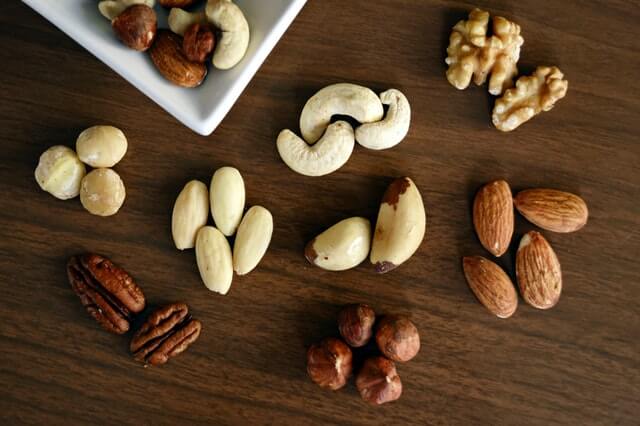
Try eating complex carbs like nuts
Do not drink on an empty stomach. Start with a light meal or snack of complex carbohydrates and protein that will help absorb the alcohol. Nuts, beans, seeds, whole grains (crackers, toast etc.), yogurt are just a few common complex carbs. Drinking may lower blood sugar levels, so theoretically some of the fatigue and headaches of a hangover may be from lack of fuel to your brain. Also, many people forget to eat when they drink, which can also cause blood sugar to drop. Eating some complex carbs, toast, crackers and juice for example can get your blood sugar back to normal.
Drink caffeine:
Drink a couple of cups of coffee. The caffeine causes your blood vessels to constrict, which can relieve the discomfort of a headache. WARNING: FOR some migraine sufferers, caffeine can be a trigger.
Try MigreLief-NOW:
MigreLief-NOW is Akeso Health Sciences’ fast-acting formula to be taken as needed by headache or migraine sufferers for neurological comfort. MigreLief-NOW contains magnesium, ginger, Boswellia, and Puracol® feverfew.
To the Best of Health,
Curt Hendrix, M.S., C.C.N., C.N.S.
A Thanksgiving Message from the MigreLief Team at Akeso Health Sciences
Back Pain and Migraines More Likely to Occur Together
A systematic review published by researchers at the University of Warwick found that there is an association between chronic low back pain and primary headache disorders, namely migraines and tension-type headaches.
Migraines and chronic lower back pain are two of the most disabling conditions worldwide. Migraines affect more than 1 billion people globally, and low back pain is the most common cause of job-related disability. Both of these conditions are a significant socioeconomic burden, costing individuals and nations billions of dollars every year in healthcare expenditures and missed workdays.

The systematic review, published by the Journal of Headache and Pain, included 14 research studies with a combined total of 460,435 participants. The results of the analysis showed a positive association between primary headache disorders and lower back pain. This association indicates that frequent back pain or chronic headaches are at least twice as likely to occur in the presence of the other.
Treating Back Pain and Migraine
Healthcare providers have always treated low back pain and primary headaches as two separate conditions. There are many drugs and natural remedies that can be beneficial to migraines and tension-type headache sufferers. Chronic lower back pain and other pain syndromes can be managed through exercise, physical and occupational therapy, and cognitive-behavioral therapy (CBT) as well as with prescription and OTC medications and certain dietary supplements. However, there aren’t many interventions that target both ailments at the same time.
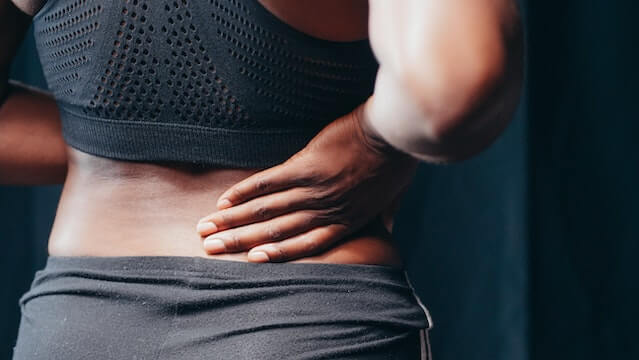
“People with persistent low back pain and people with chronic headache disorders are typically managed by clinicians from specific clinical specialties rather than experts in the management of chronic pain syndromes,” the authors note. Treating both conditions together could significantly lower costs, reduce medication overuse, and improve patient’s quality of life.
Mild or episodic back pain and headaches can be treated with OTC medications, certain dietary supplements and home remedies such as ice-packs, mindfulness meditation, and acupressure.
Several plant extracts like Ginger and Boswellia can help with back and joint pain as well as headache and migraine. Maintaining a good posture, reducing stress, and exercising frequently can also help prevent episodic headaches with back pain.
Abdominal Migraine in Children – Safe Options
Abdominal migraine is one of the most common causes of abdominal pain in children and is becoming more frequently diagnosed in adults. Although the pain will come and go, it is severely debilitating during a migraine episode, is very distressing for children. Recurring abdominal pain can have a drastic effect on a child’s overall quality of life and school performance.
Abdominal pain in childhood accounts for 2-4% of office visits to the doctor and 50% of referrals to pediatric gastroenterologists. (1) Even though it is a well-recognized type of pediatric migraine with specific diagnostic criteria under the International Classification of Headache Disorders, it is often underdiagnosed by both pediatricians and pediatric gastroenterologists. (2)
The diagnosis of abdominal migraine is much more prevalent in Europe than in the United States because in the U.S. it is often misdiagnosed as U.S. doctors are still struggling to understand it. Many doctors are only able to make an accurate diagnosis years after the abdominal migraines when the child becomes a teen and then develops classic migraines. Parents should be extra cautious as children could be subjected to unnecessary surgery if the condition is misdiagnosed.
What is an abdominal migraine?
Abdominal migraines are diagnosed in children who meet these criteria:
- At least five attacks of abdominal pain that each last 1 to 72 hours
- Dull pain around the belly button, moderate to severe in intensity
- At least two of these symptoms: appetite loss, nausea, vomiting, pale skin
Other abdominal migraine symptoms may include, headache and sensitivity to light and sound.
Who gets abdominal migraines?
- Children with a family history of migraines are at higher risk
- Occurs slightly more often in girls than boys
- Children who experience motion sickness are more likely to get abdominal migraines
- Adults susceptible to migraine
Diagnosis of Abdominal Migraine
Abdominal migraines usually follow a pattern, same type of appearance, same time of day, and the same duration with the symptoms going away completely between migraines.
Doctors may use ultrasound or endoscopy to check for other potential causes of your child’s stomach pain and evaluate your child’s medical history to determine a pattern.
Preventing Migraines
Help your child prevent migraines by discovering and avoiding their triggers if possible. The triggers for abdominal migraines are similar for regular migraines:
- Chemicals such as nitrites that are found in processed foods such as deli or processed meats, lunch meat, packaged sandwich ham, turkey, and chicken
- Caffeine
- Chocolate
- Bright lights
- Foods that contain monosodium glutamate (MSG) including Chinese food, dressings, seasonings, condiments, and many buffet foods in restaurants
- Motion sickness
- Fatigue or exhaustion
- Flickering lights
- Stress, worrying, or being upset
- Swallowing a lot of air
- Lack of sleep
In many cases, taking proactive steps to prevent migraine attacks can lead to less frequent attacks and a decrease in intensity and duration.
Where to start if your child was diagnosed with abdominal or classic migraines.
Consider a Safe & Gentle Nutritional Option…
The MigreLief Nutritional Regimen for Pediatric Migraines
Recommended by pediatric neurologists and headache specialists for almost 2 decades, MigreLief is a great place to start.
ACTION STEP 1:
Choose one of two MigreLief “daily maintenance” formulas:
Original MigreLief (age 12+)
Children’s MigreLief (age 2-11)
The caplets may be crushed or capsules opened and mixed with food such as applesauce, yogurt etc. for children or teens that have difficulty swallowing pills.
ACTION STEP 2:
Keep MigreLief-NOW “as-needed” formula on hand at all times and take whenever needed for on-the-spot help.
The ‘Dream Team’ for Migraine Sufferers
Daily and As Needed formulas work well together. While you are waiting for the daily formula to kick in, you can take MigreLief-NOW as-needed. All MigreLief formulas are drug-free, safe, gentle, and very effective.
Where to Buy?
If purchased at MigreLief.com or by calling 1-800-758-8746 you can try risk-free as there is a 90 Money Back Guarantee if you try MigreLief or Children’s MigreLief for 3 allows sufficient time for MigreLief to build blood levels for maximum effectiveness (each bottle is a one month supply). If you are not satisfied for any reason, Akeso Health Sciences will refund your purchase price.
You can also buy at the Vitamin Shoppe, Meijer stores, or at independent pharmacies nationwide. If your local pharmacy doesn’t stock it, you can ask them to order it and they can usually have MigreLief within 24 hours.
Questions? Email: HealthAdvisor@MigreLief.com or call 1-800-758-8746
Join MigreLief Fans on Facebook
Functional Neurological Disorder: What You Need to Know
Imagine having neurological symptoms like tremors or even paralysis–only tests show nothing is wrong. This is the reality for many people with functional neurological disorder (FND).
FND is a challenging and frustrating condition, much like migraine. And research suggests there’s a link between the two. But does FND cause migraines? Keep reading to find out. We’ll cover the ins and outs of FND, including symptoms, causes, and its connection to migraine.
What is Functional Neurological Disorder?
Functional neurological disorder (FND) is a condition where the brain has trouble sending and receiving signals. Unlike many neurological conditions, FND isn’t due to problems with the brain’s structure. Instead, it stems from how the brain functions.
Think of your brain like a computer. With FND, the ‘hardware’ or brain structure is fine. The problem lies with the ‘software’ program running the computer.
These ‘software’ issues can lead to neurological symptoms that affect how you move, speak, walk, think, or feel.
Symptoms of FND
Symptoms of FND
FND symptoms vary from person to person. Some people may only have one or two symptoms. Others may have several.
FND symptoms may include:
- Weakness or paralysis
- Tremors, jerks, twitches, tics, or spasms
- Trouble walking
- Numbness
- Seizures or episodes of uncontrolled shaking and loss of consciousness (not from epilepsy)
- Memory issues
- Trouble concentrating
- Speech difficulties like slurred speech, stuttering, or loss of speech
- Trouble swallowing
- Dizziness
- Visual symptoms like blurred vision, double vision, or sensitivity to light
- Hearing problems
FND is also linked with several other symptoms and conditions, including:
- Fatigue
- Chronic pain
- Insomnia
- Migraines and other types of headaches
- Irritable bowel syndrome (IBS)
- Depression and anxiety
- Urinary retention
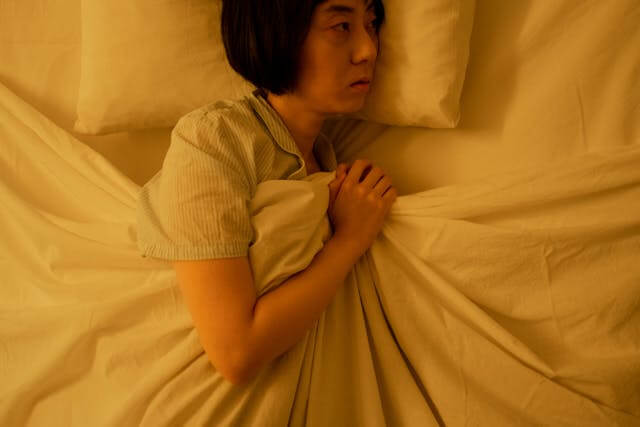
Symptoms vary in intensity and may come and go or persist. They tend to get worse when given attention and decrease when distracted.
For some people, FND symptoms are short-lived. For others, they may go on for many years.
Like migraine, when these symptoms persist it can seriously interfere with your ability to function in day-to-day life.
What Causes FND?
It’s not entirely clear. Scientists suggest many psychological, social, and biological factors may play a role.
Stress or emotional or physical trauma may trigger FND for some people. But others may have no identifiable trigger at all.
Some research suggests the limbic system may be overly active in people with FND. The limbic system is the part of your brain in charge of emotions, memory, and learning.
Other studies show that the part of the brain involved in self-agency–the feeling of being in control of your life–may be impaired with FND.
Many things can increase the likelihood of developing FND.
Risk factors include:
- Having another neurological condition such as migraine, epilepsy, or a movement disorder
- Mental health conditions like depression, anxiety, PTSD, personality disorders, or dissociative disorders
- History of sexual abuse, trauma, or neglect in childhood
- Recent stress or high levels of ongoing stress
According to research, women are two to ten times more likely to develop FND than men. It often develops in the teenage years and rarely occurs in children under the age of five.
FND and Migraine: What’s the Link?
FND has many comorbidities, including migraine. In fact, one study found FND symptoms were twice as common among migraineurs.
The same study showed FND symptoms usually occur within 6 months or at the same time that migraine symptoms emerge. What’s more, treating migraine led to a decrease or remission in FND symptoms.
In addition, some symptoms of FND and migraine are quite similar. For example, visual disturbances are common with FND, as well as migraine with aura. And numbness, weakness, or paralysis can be a sign of FND or hemiplegic migraine.
Because of the similarities, the lines between the two conditions can get blurry.
Does FND Cause Migraines?
While there’s a connection between the two, no evidence shows that FND causes migraines.
However, research does suggest that migraine attacks may trigger FND seizures. In one scientific review of patients with FND seizures, migraine attacks triggered seizures in 65% of patients.
In addition, 73% of FND patients with follow-up data had reduced FND symptoms when treated with migraine prophylactic meds.
More research is certainly needed. But this does show an inextricable link between the two conditions.
How is FND Diagnosed?
FND can be tricky to diagnose since its symptoms mimic so many other conditions. Not to mention, there aren’t any tests or biomarkers that can confirm a FND diagnosis.
Since FND isn’t due to structural issues in the brain, tests like CT scans and MRIs typically come back normal. This may explain why, on average, it takes about 7 years to get a FND diagnosis.
Diagnosis is usually made by a neurologist or in some cases a psychiatrist. The doctor collects a thorough health history and does a physical examination, taking note of any signs of FND.
The neurological exam may include tests like Hoover’s sign to check for clinical signs.
The doctor will also compare your symptoms to the FND criteria in the DSM-V by the American Psychiatric Association, which are as follows:
- One or more symptoms that affect your movement or senses
- Symptoms can’t be explained by another neurological disorder or a mental health disorder
- Symptoms cause significant impairment in school, work, or social life
Treatment for FND
FND treatment varies depending on the symptom profile. That said, education is the first step to successful treatment for all patients.
The more patients understand FND, that their symptoms are real, and that recovery is possible– the more motivated they’ll be in their treatment.
Many FND treatments aim to ‘retrain the brain’ to form new patterns. Treatments may include:
- Cognitive behavioral therapy (CBT) can be helpful for FND, especially if it’s related to stress or trauma. CBT helps patients become aware of unhelpful thought patterns and how they relate to emotions and behaviors.

- Physical therapy. Working with a physical therapist can help FND patients struggling with movement symptoms like weakness or gait issues. When done regularly, exercises can help retrain movement patterns and build strength.
- Lifestyle changes. Stress reduction techniques like progressive muscle relaxation, meditation, yoga, or breathing exercises may benefit some people with FND. Since symptoms often increase with attention, distraction techniques like listening to music or talking to someone may also help.
- Transcranial magnetic stimulation (TMS): TMS uses magnetic pulses to stimulate nerve cell activity in the brain. While more research is needed, some studies show TMS may improve FND symptoms.
- Medication: FND isn’t typically treated with medications. However, if a patient has a comorbid condition like migraine, prescription or OTC medications or may help. Studies show FND symptoms improve when migraine is treated. Migraine prophylactic meds like beta blockers are one option.
- Nutritional Support: Nutritional support in the form of dietary supplements such as magnesium, riboflavin, and feverfew for healthy neurological function may also make a difference.
Takeaways
Functional neurological disorder is a puzzling condition that can severely disrupt your life. The good news is that FND is often reversible. While remission doesn’t happen overnight, it is possible with the right treatment. Retraining your brain you can help change symptoms affecting your movement, speech, or thinking.
Migraines are common among those with FND and can trigger symptoms. Supporting a healthy neurological system is key whether through healthy lifestyle habits or nutritional support.
Sources:
- https://www.nhsinform.scot/illnesses-and-conditions/brain-nerves-and-spinal-cord/functional-neurological-disorder/
- https://www.ninds.nih.gov/health-information/disorders/functional-neurologic-disorder
- https://www.ncbi.nlm.nih.gov/pmc/articles/PMC8111317/
- https://www.ncbi.nlm.nih.gov/books/NBK551567/
- https://jnnp.bmj.com/content/91/8/e19.2
- https://www.sciencedirect.com/science/article/abs/pii/S1525505023003566
- https://www.ncbi.nlm.nih.gov/pmc/articles/PMC6306282/
- https://pubmed.ncbi.nlm.nih.gov/25121372/
The Link Between PTSD and Migraine: Breaking it Down
When people think of PTSD, flashbacks, anxiety, and hypervigilance are usually the first things that come to mind. Not migraines. And while headaches aren’t a textbook sign of the disorder, there’s a strong link between PTSD and migraine. Mounting evidence shows people with PTSD are far more likely to deal with migraine than those who don’t. In this article, we’ll break down the research connecting migraine and PTSD and offer tips for how to manage both conditions.
What is Post Traumatic Stress Disorder (PTSD)?
PTSD is a disorder that occurs as a response to a traumatic situation. While trauma comes in all shapes and forms, the most common events to trigger PTSD include:
- Military combat
- Natural disasters
- Serious accidents
- Childhood or domestic abuse
- Physical or sexual assault
- Death of a loved one
- Serious injuries or health conditions

That said, only 1 in 3 people who go through severe trauma develop PTSD.1 No one knows why some develop the disorder, while others don’t.
Genetics, particularly a family history of mental health problems, likely plays a role. Yet lack of social support may also contribute to PTSD.
While the disorder is commonly associated with war veterans, anyone at any age can develop PTSD.
PTSD symptoms
Typically, symptoms arise within three months after being exposed to a traumatic event. But in some cases, symptoms may not emerge until years later.
Symptoms of PTSD include:
- Flashbacks, nightmares, or intrusive thoughts reliving the traumatic event
- Avoiding places, objects, or situations that may trigger distressing memories
- Feeling guarded, on edge, or easily startled
- Having irritable or angry outbursts
- Distorted thoughts about oneself
- Feelings of guilt, shame, or inability to feel positive emotions
- Reckless or destructive behavior
- Trouble falling or staying asleep
Due to the nature of PTSD, it’s no surprise that depression and anxiety are common comorbidities. Yet, PTSD can impact your physical health as well. Patients with PTSD face a greater risk of arthritis, heart problems, and digestive disorders, such as GERD.2 But pain often goes hand in hand with PTSD as well. For example, in one study of people with chronic low back pain, 51% also had PTSD symptoms.3 Headaches are also a common complaint in those with PTSD.4
The Relationship Between PTSD and Migraine
There is an undeniable link between PTSD and migraine. It’s estimated that roughly 8% of the population has PTSD. Yet the frequency of PTSD is much greater in those with migraine.
One study from the journal Headache found that 22.4% of people with episodic migraine had symptoms of PTSD.5 The results with chronic migraine were even more dramatic, with 30.3% of patients having signs of PTSD.
Another study examined the prevalence of PTSD among patients with tension headaches or chronic migraine. Out of 60 healthy control patients, five had PTSD (8%).6 Compare that to 40% of migraine patients and 13.3% of patients with tension headaches.
What’s more, childhood trauma and migraines often go hand in hand. Research shows migraine is more common in people with a history of emotional, physical, or sexual abuse than in the general population.7
Clearly, there’s a bidirectional link between the two conditions. But the mechanisms connecting the two aren’t entirely understood.
Does PTSD Cause Migraine?
For now, it’s unclear. One study found that 69% of episodic migraine patients had PTSD symptoms before the onset of their migraines.8 This suggests PTSD may trigger migraine, yet further research is needed to understand the link. About 80% of people with migraine report stress as a common trigger.9 And since PTSD involves living in a state of hyperarousal, the connection makes sense.
PTSD can cause your nervous system to stay stuck in ‘fight or flight’ mode. Staying in the stress zone for too long may cause abnormal activity of the trigeminal nerve, which is linked with migraine10 Stress also creates chronic inflammation, which may alter pain perception. Yet migraine may trigger PTSD symptoms as well. Living with migraine presents plenty of stressors. Migraine episodes can take a toll on work, relationships, and social life. These challenges may exacerbate symptoms of PTSD, creating a vicious cycle.
Managing PTSD with Migraine
Both PTSD and migraine are complex conditions. So treatment involves a comprehensive approach. Therapy, lifestyle changes, and medications are typically the recommended treatments.
Cognitive behavioral therapy is shown to be particularly helpful for PTSD patients with migraine. CBT works to shift dysfunctional thought patterns that may be contributing to stress and anxiety. CBT can also help you learn coping strategies for managing both conditions.
Shifting lifestyle habits can also help ease symptoms of both disorders. Meditation, mindfulness, and breathing exercises can all help calm the nervous system and ease stress.
Antidepressant medications such as selective serotonin reuptake inhibitors are often prescribed for PTSD patients as well. These meds may help lessen the severity of symptoms. Yet, these drugs often come with a long list of side effects.
Luckily, there are also natural options for calming an overactive stress response. Nutritional support can help address any underlying imbalances that may stir up anxiety or migraine. We carry two formulas that may offer relief:
Calm and Clever includes herbs and nutrients that reduce cortisol, helping to ease anxiety and lower the stress response.
Migrelief contains a triple shot of nutritional support for migraine sufferers, with magnesium, riboflavin, and Puracol® feverfew. For fast-acting neurological comfort for both migraine or headache sufferers, MigreLief-NOW (rescue formula) can make a big difference. MigreLief has been recommended by neurologists and headache specialists for over 25 years.
Akeso Health Sciences offers a 20% discount to all military personnel year-round. Click here to claim your discount code.
Takeaways
The link between PTSD and migraine is clear. Migraine is much more common in people with PTSD – and vice versa. Both disorders involve an overactive stress response. But the mechanisms behind the connection are unknown for now.
While both conditions are complex, coping strategies may help manage symptoms. Relaxation techniques, therapy, and nutritional support can help ease stress and anxiety, which may offer symptom relief.
The Truth About Chocolate and Migraine: Trigger or Craving?
Ever reached for chocolate, only to be hit by a migraine soon after? If so, you’re not alone. Chocolate tops the list of migraine-trigger foods. But is chocolate really the culprit, or just an innocent bystander? After all, some people with migraine eat chocolate without any issues.
Which begs the question: Does chocolate truly trigger migraine–or do we just crave chocolate before a migraine strikes? Keep reading as we dive into the research on the link between chocolate and migraine.
Does Chocolate Trigger Migraine Attacks?
According to a 2020 review in the journal Nutrients, there isn’t solid evidence to back this up.
The review looked at 25 studies to assess whether the whole ‘chocolate is a migraine trigger’ myth was true. Of those, 23 studies found chocolate to be a migraine trigger–but only for a small group of people. It varied from 1.3% to 33% depending on the study.
And here’s the kicker. Most of those studies had participants recall their triggers from a list once their migraine was over. Meaning, their beliefs about migraine triggers could heavily influence the results.
What’s more, three of the studies were double-blind and compared chocolate as a migraine trigger to a placebo. They found no difference between the chocolate and placebo groups in triggering migraine.
So for now, the evidence is unclear. More research is needed to understand chocolate’s role in migraine. But clearly, chocolate isn’t a problem for all migraineurs.
Can Migraines Make You Crave Chocolate?
Much of the chocolate migraine fear comes from personal anecdotes. Someone eats a hunk of chocolate cake and then gets a migraine shortly after. Their mind backtracks to what may have caused the attack and chocolate gets the blame.
While it may seem like chocolate is the culprit–the chocolate cravings may be a sign of an impending migraine.
Food cravings are a common symptom of prodrome, the first phase of a migraine attack. During prodrome, also known as the premonitory phase, your body sends signals that a migraine is on its way.
Common prodrome symptoms include yawning, fatigue, neck pain, and yes–cravings for certain foods. You can learn more about prodrome here.
The most common prodrome cravings are for sugary, fatty, and salty foods. And chocolate checks off the sugary and fatty boxes to a T.
Prodrome symptoms are usually more subtle than the aura or headache phase. Because of this, they often fly under the radar and people miss them.
This can make people assume chocolate caused their migraine attack. When really, their chocolate craving was a sign a migraine had already started.
The Stress, Hormone, and Chocolate Connection
Another thing to consider is the connection between chocolate, hormones, and stress.
Stress is by far the most common migraine trigger–affecting nearly 80% of migraineurs. And as you may have noticed, we tend to crave more sweets when we’re stressed.
That’s because when we’re under stress our body needs more energy. And chocolate’s combo of sugar and caffeine makes it the perfect food for a quick shot of energy.
So you eat a chocolate bar, get a migraine a few hours later, and figure the chocolate must have caused it. When really stress was the true trigger.
Hormones may play a role as well. Many women get ‘menstrual migraines’ right before their period due to hormonal shifts. And chocolate cravings are common this time of the month too. As estrogen and progesterone dip, it can stir up cravings for sugar and carbs to boost your energy and mood.
Meaning, you may reach for chocolate because your hormones are off, get a migraine, and then assume the chocolate was the bad guy. When hormone changes were really to blame.
Should People With Migraine Avoid Chocolate?
It depends. If you notice you get migraines every time you eat chocolate without fail, then you may want to avoid it.
But most people with migraine can eat chocolate without any issues.
There’s not enough evidence to prove if chocolate is really a migraine trigger. Even if it was, migraine triggers vary from person to person. Just because your best friend gets migraines after they eat chocolate, doesn’t mean you will.
Keeping a migraine diary can help you nail down your unique triggers. Be sure to track those subtle prodrome symptoms too like neck pain, fatigue, or excessive yawning. This can help you pinpoint if chocolate is really a trigger–or if a migraine was already in motion.
You may find you’re fine with small amounts of chocolate. But since chocolate is high in sugar, it’s best to not overdo it–whether you have migraine or not!
Eating a healthy diet is a key part of migraine prevention. So when you do indulge, opt for healthier versions like dark chocolate, ideally with at least 70% cacao.
Benefits of Dark Chocolate for Migraineurs
While chocolate may get a bad rap, it contains many beneficial compounds for people with migraine.
For example, chocolate is rich in magnesium and riboflavin–two key nutrients for migraine prevention.
Magnesium is a mineral that relaxes blood vessels and calms overexcited nerves that can trigger migraines. Unfortunately, people with migraine tend to have lower levels of magnesium.
The good news? Studies show supplementing with magnesium can help prevent migraines. And dark chocolate is a delicious way to add more magnesium to your diet.
Chocolate is also high in riboflavin (vitamin B2), a nutrient that boosts mitochondrial function. Mitochondrial dysfunction is said to play a role in migraine. Riboflavin supplementation can reduce the frequency and duration of migraine attacks, according to research.
On top of that, dark chocolate is high in tryptophan, an amino acid that converts into the ‘feel good’ neurotransmitter serotonin. People with migraine often have low levels of serotonin. When serotonin is low, it can cause depression and dilate the blood vessels, which may trigger migraine.
Eating more tryptophan-rich foods like dark chocolate is an easy way to increase your serotonin. This may, in turn, boost your mood and help keep migraine at bay. One study found that people who consumed more tryptophan in their diet were 54-60% less likely to develop migraine.
Takeaways
There isn’t enough scientific evidence to prove if chocolate is truly a migraine trigger. Yes, a small number of people get migraine attacks after eating chocolate. But not enough for chocolate to be off-limits for all migraineurs.
Many people also get cravings for sugary foods like chocolate during the first stage of migraine. This means their chocolate cravings may be a symptom that their migraine already started.
If you feel strongly that chocolate is a trigger for you, then, by all means, avoid it. But many migraineurs are fine with small amounts of chocolate. This is good since chocolate has many beneficial nutrients for migraine, like magnesium, riboflavin, and tryptophan.
In the end, what you choose to eat, or not eat, is up to you. To learn more about your triggers, download our free migraine diary and trigger tracker.
Sources:
- https://www.ncbi.nlm.nih.gov/pmc/articles/PMC7146545/
- https://www.ncbi.nlm.nih.gov/pmc/articles/PMC8088284/
- https://www.ncbi.nlm.nih.gov/pmc/articles/PMC7146545/
- https://www.ncbi.nlm.nih.gov/books/NBK507271/
- https://www.frontiersin.org/journals/physiology/articles/10.3389/fphys.2023.1133528/full
- https://pubmed.ncbi.nlm.nih.gov/26780280/
- https://www.ncbi.nlm.nih.gov/pmc/articles/PMC4117050/
- https://pubmed.ncbi.nlm.nih.gov/31254181/
Ehlers-Danlos Syndrome: Understanding the Condition and Its Connection to Migraine
Living with migraine is challenging enough. But adding Ehler-Danlos syndrome on top of it takes those challenges to a whole new level.
Ehlers-Danlos syndrome (EDS) is a connective tissue disorder that can affect the skin, joints, muscles, and blood vessels. Joint dislocations, fragile skin, and chronic pain are common among those with EDS. And like many health conditions, EDS occurs more often among those with migraine.
In this article, we’ll cover what EDS is, along with symptoms, causes, and its connection to migraine.
What is Ehlers-Danlos Syndrome?
Ehlers-Danlos Syndrome (EDS) is an umbrella term that refers to a group of connective tissue disorders. Your connective tissue acts as the “glue” that holds your organs in place. It’s made of a mix of substances and proteins, including collagen and elastin.
Collagen is a protein that provides strength and structure to your body and helps maintain skin elasticity. Unfortunately, people with EDS have a gene that affects their collagen production. Because of this, their connective tissues are weaker than they should be. This can lead to a variety of issues, including fragile skin and loose joints.1
Types of EDS
There are 13 different types of Ehlers-Danlos syndrome. While we won’t cover them all in this article, here are three of the most common:
Hypermobile EDS
Hypermobile EDS (hEDS) is the most common type, representing about 80-90% of EDS cases.2 The hallmark sign of hEDS is joint hypermobility. Meaning, the joints move more than they should.
Classical EDS
Classical EDS (cEDS) is a type of EDS that can cause fragile, overly stretchy skin. People with this form often scar or bruise more easily.
Vascular EDS
Vascular EDS (vEDS) is a less common form of EDS, but more severe. Vascular EDS can cause the blood vessels and organs to rupture more easily. This can lead to internal bleeding and increase the risk of stroke.3
How Common is EDS?
Not at all. Ehlers-Danlos syndrome is rare, affecting roughly 1 in 5,000 people worldwide (0.02%).4 To put this in context, about 10% of people live with migraine.
As mentioned, hypermobile EDS is the most common, affecting between 1 in 10,000 to 1 in 15,000 people. Classical EDS affects between 1 in 10,000 and 1 in 20,000 people.
Ehlers-Danlos Syndrome Symptoms
Symptoms vary depending on the type of EDS. However, some of the most common EDS symptoms include:5
- Joint hypermobility. People with EDS often have overly flexible joints. For example, they may be able to bend forward and place their hands flat on the ground. This is because the connective tissue that holds their joints in place is weaker. This can increase the risk of joint pain and dislocations.
- Stretchy skin. Weaker connective tissue can make the skin unusually stretchy. This is known as skin hyperextensibility. Skin may also have a soft, velvety texture.
- Tissue fragility. When the connective tissues are more fragile, the skin and organs are more prone to damage. This can lead to easy bruising, unusual scarring, and poor wound healing.
Other symptoms of EDS include:1,5
- Fatigue
- Joint and muscle pain
- Trouble concentrating
- Digestive issues like heartburn and constipation
- Poor muscle tone
- Dental issues like gum disease
- Hernias
- Pelvis organ prolapse
- Urinary incontinence
- Headaches
What Causes Ehlers Danlos Syndrome?
In short, genetics. Currently, 20 different genetic variants are linked with EDS.3 Each type of EDS can be traced to a specific gene mutation. These genes all affect your body’s ability to produce collagen.
The parts of your body affected depend on the type of genetic mutation you have. In some forms of EDS, multiple genes are involved.5
Since EDS is a genetic disorder, it can be inherited from your parents or passed onto your children. However, it’s possible to get EDS even if your biological parents didn’t have it.
EDS and Migraine: What’s the Connection?
It’s no secret that migraine has a long list of comorbidities. And it turns out, Ehlers-Danlos syndrome is one of them.
No research indicates that Ehlers-Danlos syndrome causes migraine. However, there is a link between the two.
While hypermobility is the textbook sign of EDS, headaches are also common. In fact, it’s estimated that up to 70% of people with EDS get regular headaches.6
Of all headache types, the most prevalent ones among those with EDS are migraine without aura and migraine with aura.7 One study of over 1.6 million Israeli teens found that migraine was twice as common among those with EDS.8
In addition, migraine tends to be more severe among people with EDS.
One study published in Neurological Sciences compared migraine in 33 patients with hypermobile EDS to 66 patients suffering solely from migraine. They found that those with EDS had an earlier onset of migraine (12.6 vs 17.0 years of age).9
In the study, patients with EDS also had more frequent migraines (15 days per month vs 9.3) and more adverse effects on their quality of life.9
Why is Migraine Worse with EDS?
It’s not entirely clear. But some suggest stress could play a role.
Like migraine, living with EDS can take a toll on a person physically and mentally. And stress is the number one migraine trigger. The increased stress of living with EDS may worsen migraine symptoms.
In addition, people with EDS often suffer from comorbid conditions. This includes postural orthostatic tachycardia syndrome (POTS) and mast cell activation syndrome (MCAS).10 Like EDS, these conditions can increase the risk of migraine and potentially make symptoms more severe.
Plus, many people with EDS may turn to medications like aspirin or ibuprofen to manage pain. If used regularly, these may contribute to medication overuse headaches.
How is EDS Diagnosed?
Each type of EDS has its own criteria for diagnosis. This consists of a set of symptoms that characterize each condition.
If your doctor suspects you have EDS, they’ll likely do a physical examination with a series of tests. This may include:
- Checking your skin to assess how stretchy it is and to look for scars and bruises.
- Seeing how far you can bend joints like your wrist, elbows, knees, or fingers. For example, can you lift your pinkie finger beyond a 90-degree angle? Or can you bend your knees backward?
- A medical history to see if anyone in your family has dealt with these symptoms before.
Genetic testing can also pinpoint genes related to the rarer forms of EDS. But keep in mind, if no genetic mutations show up, you could still have EDS. You just may have a genetic variant not included in that test.
Other tests may also be recommended depending on the severity of your symptoms. This may include a CT scan, MRI, or echocardiogram.
Managing EDS & Migraine
There’s no cure for EDS. However, certain treatments can help you manage your symptoms. Since EDS can affect multiple body parts, you may need a team of specialists to manage your care.
Treatment will vary depending on your symptoms and the type of EDS you have but may include:
- Physical therapy can strengthen the muscles around your joints. This may help prevent injuries and reduce the risk of dislocations.
- Occupational therapy can help you adjust your daily living to reduce the risk of injuries. They may recommend devices like braces for extra joint support.
- Low-impact exercises like walking, swimming, and pilates help build muscle tone without putting too much pressure on the joints. Contact sports, heavy lifting, and high-impact exercise can increase the risk of dislocations. So it’s best to avoid them.
- Mindfulness practices like meditation are shown to relieve stress, increase body awareness, and reduce sensitivity to pain.11 This can be helpful for both EDS and migraine.
- Skincare routines may need to be adjusted to protect fragile skin. Avoid harsh soaps and vigorous scrubbing and opt for gentle cleansers instead. Wearing sunscreen every day is a must too.
- Hydration is key for EDS and migraine. Drinking plenty of water keeps your joints lubricated and helps maintain tissue elasticity. Dehydration is also a common migraine trigger. Aim to drink at least 2 liters of water a day.
- Nutrition is a crucial part of treating any health condition, including EDS and migraine. Processed foods can cause inflammation and trigger migraine, so it’s best to avoid them. Instead, opt for a diet rich in wholesome foods like fruits, veggies, whole grains, legumes, nuts, and seeds. This will flood your body with vitamins, minerals, and antioxidants to promote healing.
- Dietary supplements should be considered to fill nutritional gaps and support neruological health and comfort such as MigreLief (daily maintenance) and MigreLief-NOW (as-needed / at first warning signs – support for neurological and overall comfort.)
Living with Ehlers Danlos Syndrome
EDS is a lifelong health issue. The good news is, once you learn how to manage your EDS symptoms, you should be able to enjoy your usual activities. However, you’ll want to steer clear of extreme activities like contact sports to avoid injury.
Some people with EDS also have migraine, which adds another layer of challenge. But you have more power than you think. Keeping a heathy lifestyle with a nutritious diet, regular exercise, proper hydration, and mindfulness can help keep your body balanced which may reduce future flares.
Sources:
- https://www.ncbi.nlm.nih.gov/books/NBK549814/
- https://www.aafp.org/pubs/afp/issues/2021/0415/p481.html
- https://medlineplus.gov/genetics/condition/ehlers-danlos-syndrome/
- https://www.ncbi.nlm.nih.gov/books/NBK549814/
- https://www.ehlers-danlos.com/what-is-eds/
- https://www.migraineagain.com/ehlers-danlos-syndrome-headaches-and-migraine/
- https://link.springer.com/article/10.1007/s10072-015-2173-6
- https://headachejournal.onlinelibrary.wiley.com/doi/full/10.1111/head.14526
- https://pubmed.ncbi.nlm.nih.gov/25791889/
- https://link.springer.com/article/10.1007/s11910-023-01307-w
- https://www.ncbi.nlm.nih.gov/pmc/articles/PMC4941786/
Prevent Summer Migraines
While there is much to love about summer- longer days, outdoor picnics, trips to the beach, pool time and nighttime barbecues, summer months can also increase the risk of debilitating migraines. Hotter temperatures, barometric pressure changes, and high humidity make many migraine sufferers more susceptible to an attack.
What triggers migraines during the summer?
A host of factors make summer one of the worst seasons for migraine attacks. For example, dehydration, a common migraine trigger, is more likely to occur during the summer months when the weather is warm and during periods of profuse sweating where people lose more fluid than they take in.
Other factors may trigger migraines during the summer months, including:
• High humidity
• High winds
• Longer days (which can change sleeping patterns)
• Typical summer foods and drinks (hot dogs, bacon, sausage, soda, alcohol, pre-made sauces like BBQ sauce, chips, candy, etc.)
• Barometric pressure changes
But even though migraines often rob us of summer’s little pleasures, there are things you can do to minimize your risk and ward off triggers. Here are some helpful tips for avoiding migraines and headaches this summer:

How do you avoid a summer migraine?
Stay well hydrated.
For many migraine sufferers, even mild dehydration is the quickest way to a migraine attack. To avoid getting dehydrated while you are out and about, carry a water bottle with you at all times and drink 6 to 8 ounces every hour. Drinking water is not the only way to stay hydrated: fruits and veggies with high water content like grapes, watermelon, celery, and cucumber are fun and effective hydration options perfect for pool or beach days.
Wear sunglasses.
Many migraine sufferers are sensitive to light before, during, or even after an attack (photophobia). 85 to 90 percent of migraineurs experience photophobia which is why so many migraine sufferers seeking migraine relief, lie down in a dark room.
Some migraineurs swear by dark, polarized, tinted, or FL-41 lenses, but keep in mind that there is no right or wrong way of choosing sunglasses for your migraines. The perfect pair will be the one that sits comfortably on your face, provides adequate UV ray coverage, and reduces discomfort. It is important to choose frames with good eye-coverage that can help block light that comes from above, that comes from the side, and that causes glare that comes from the back.
You may also need to wear your sunglasses indoors to deal with fluorescent lights, computer screens, etc. However, wearing sunglasses indoors too much can lead to something called chronic dark adaptation, which can make your sensitivity to light even worse. If you have to wear sunglasses inside, be sure to take them off every hour or so to avoid getting chronic dark adaptation. Consider decreasing glare and brightness by turning off fluorescent lights or adjusting or tinting your computer screen.
Cool down with cold-therapy ice caps. While migraine and headache relief ice gel caps are great for fast relief, they are also great for cooling down and relaxing on a hot day. Keep the convenient one-size fits most, form-fitting soft gel compression cap in the freezer and slip on whenever you need cool comfort or migraine and headache relief.

Maintain a consistent sleep schedule.
With longer days and shorter nights, you probably find yourself going to bed later and waking up earlier than usual. Daylight hour changes can be very disruptive to sleeping routines; humans are wired to sleep after the sun sets and wake up when it rises. But during the summertime, the earth tilts on its axis ever so slightly, bringing more daylight hours to most places around the world.
Sleep deprivation is a potent migraine trigger, but you can avoid it by sticking to a regular sleeping schedule, making sure your room is dark, the temperature is pleasant, and limiting your sugar and caffeine consumption before bed.
Before you give in to the inevitability of waking up with a migraine, consider a natural sleep aide to help you reset your internal clock and ease back to sleep. Natural supplements with melatonin, valerian root extract, or magnesium are all safe and effective options.
Avoid Fragrances.
Fragrance-loaded summer products like sunscreens are important to avoid if you are susceptible to this migraine trigger. Try to purchase fragrance-free products when possible.
Manage Stress.
Although summer is a carefree time of fun and relaxation, many people may experience what some call a “let-down” migraine because they occur on the first day of vacation or the start of a weekend. According to a study conducted by researchers at the Montefiore Headache Center and Albert Einstein College of Medicine at Yeshiva University, in the first six hours of reduced stress, a person’s risk of getting a migraine attack increases nearly five times, an effect that lasts up to 24 hours. The researchers found that relaxation following heightened stress was an even more significant trigger for migraine attacks and reduced stress from one day to the next significantly increased risk of migraine onset on the following day.

Practice mindfulness in order to reduce stress
It is important for people to be aware of rising stress levels and attempt to relax during periods of stress, rather than allowing a major build-up. Rising temperatures are also known to increase levels of the stress hormone cortisol. Practicing mindfulness or yoga and taking natural supplements to help maintain healthy levels of cortisol are great ways to manage stress and prevent migraines.
On-the-Spot Nutritional Support
If you are using MigreLief Original daily formula, don’t forget to pack it along on any trip you may be taking. It is available in a small travel-size bottle. Be sure to keep MigreLief-NOW close by, in your purse or backpack in case of emergencies for on-the-spot neurological comfort during difficult times.
Relax, enjoy your summer, and stay safe.
When your out and about this summer, remember to avoid heat-related illnesses. Avoid becoming overheated. While having fun and the sun, be sure to seek out shade occasionally, drink plenty of water and cool down by misting yourself with a spray bottle of water.
